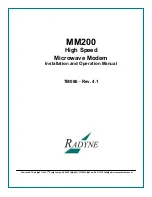
5 PTC-Firmware
5.9.1
Connecting the GPS receiver
The GPS receiver must be connected to the secondary serial port of the PTC-IIex. The
input and output of the secondary port is brought out to the normal SUB-D plug of the
RS232 interface, and is available from there.
The secondary port input is connected to pin 4 of the RS232 socket. The secondary port
output is connected to pin 9 of the RS232 socket. (Ground is connected to pin 5. Do not
forget the ground connection!)
SCS offers a special Y cable which splits the leads to and from the RS232 socket on the
PTC-IIex so that two separate DIN-9 RS232 standard sockets are available. By using the
Y cable, it is possible to connect a GPS receiver and a PC to the PTC-IIex without
needing a soldering iron. Refer to chapters
and C4 on page
details.
GPS receivers normally work at a speed of 4800 Bd from their serial NMEA output. The
PTC-IIex normally operates automatically at 4800 Bd on its secondary serial port.
Some GPS receivers offer various protocolls for control via the serial port. The PTC-II
expects a NMEA compatible GPS receiver. The GPS equipment must therefore be set
to "NMEA compatible"!
5.9.2
GPS position request
As soon as a GPS receiver is connected, the PTC-IIex evaluates the incoming data and
saves the actual position with the corresponding (GPS) time. The user can call up this
position data with the
POSition
command in the
cmd:
- menu.
The PTC-IIex accepts messages in formats GPRMC, GPGLL, IIRMC and IIGLL. RMC
has priority over GLL.
The
POSition
command is also a remote control command, and available for use via
PACTOR and PR. It can also be called up by users of the PTC-box.
Hostmode programs can use the channel 249 to directly access the NMEA data of a
connected GPS receiver (refer to chapter
).
5.10
APRS
APRS (Automatic Position Reporting System) was developed 1992 from Bob Bruninga
(WB4APR) as a special operating mode of Packet-Radio, as the name implies, for
automatic transfer of position data.
APRS is mainly used for tracking of mobile
objects
. For that the actual position is read
out from a GPS receiver (“GPS” operation). But also without GPS receiver connected
fix
position data can be transmitted (“FIX” operation). In this case the position needs to be
entered manually.
The PTC-IIex operates this mode stand alone and without being connected to a PC!
To setup the APRS features the command
APRS
in the
pac:
-menu is available (refer to
chapter
). Also here the parts of the commands written in capital letters
are necessary to enter to invoke the command. The first argument following the
APRS
command usually acts as a sub-command and selects a function. The final parametes are
1
APRS is registered Trademark of the APRS Engineering LCC, USA
31
Summary of Contents for PTC-IIex
Page 14: ...List of Figures and Tables XII...
Page 30: ...3 Installation 16...
Page 108: ...7 Audio 94...
Page 126: ...8 FAX 112...
Page 173: ...12 SYStest 159...
Page 183: ...14 Circuit Description 169...
Page 195: ...15 Basics 181...
Page 201: ...B Technical Data 187...
Page 202: ...C Layout Appendix C 19 Layout B 1 Motherboard Figure B 1 Motherboard 188...
Page 203: ...C Layout 189...
Page 215: ...Index 202...
















































